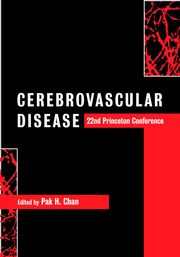Book contents
- Frontmatter
- Contents
- List of contributors
- Preface
- Acknowledgments
- Part I Special lectures
- Part II Oxidative stress
- Part III Apoptosis
- Part IV Hot topics
- Part V Hemorrhage, edema and secondary injury
- Part VI Inflammation
- 18 Inflammation and stroke: benefits or harm?
- 19 TNF-α and ceramide are involved in the mediation of neuronal tolerance to brain ischemia
- 20 Sites and mechanisms of IL-1 action in ischemic and excitotoxic brain damage
- 21 Protease generation, inflammation and cerebral microvascular activation
- Part VII Gene transfer and therapy
- Part VIII Neurogenesis and plasticity
- Part IX Magnetic resonance imaging in clinical stroke
- Part X Risk factors, clinical trials and new therapeutic horizons
- Index
- Plate section
18 - Inflammation and stroke: benefits or harm?
from Part VI - Inflammation
Published online by Cambridge University Press: 02 November 2009
- Frontmatter
- Contents
- List of contributors
- Preface
- Acknowledgments
- Part I Special lectures
- Part II Oxidative stress
- Part III Apoptosis
- Part IV Hot topics
- Part V Hemorrhage, edema and secondary injury
- Part VI Inflammation
- 18 Inflammation and stroke: benefits or harm?
- 19 TNF-α and ceramide are involved in the mediation of neuronal tolerance to brain ischemia
- 20 Sites and mechanisms of IL-1 action in ischemic and excitotoxic brain damage
- 21 Protease generation, inflammation and cerebral microvascular activation
- Part VII Gene transfer and therapy
- Part VIII Neurogenesis and plasticity
- Part IX Magnetic resonance imaging in clinical stroke
- Part X Risk factors, clinical trials and new therapeutic horizons
- Index
- Plate section
Summary
Introduction
Stroke is the third leading cause of death in most developed countries and the primary cardiovascular cause of death in Japan and China. The health burden of the disease is staggering, as loss of a productive life inflicts a heavy toll on patients, families and the society at large. Yet, this disease has no effective therapeutic treatment beyond a limited (about 2%) treatment with thrombolytics that has a significant adverse effect, and despite intense research efforts and numerous clinical trials to develop drugs to reduce morbidity and mortality. Over the past two decades, the focus of drug development efforts has targeted modulators of ion channels (Ca2+, Na+), scavengers of oxygen radicals and antagonists of excitotoxic neurotransmitters (primarily glutamate and glycine receptors). However, all phase III clinical trials with these compounds (Table 18.1), where such compounds were tested for efficacy of treatment in ischemic stroke, have failed due to lack of efficacy, adverse effects or other development difficulties. Debates on the reasons for this grim reality have sprung up in recent meetings, where “finger pointing” to possible causes of failure include wrong animal models, wrong mechanism of action, poor clinical design, inadequate timing of treatment, etc. While this debate is ongoing, the stroke research community seems to have been disenchanted by the “classic” targets for drug development (vide supra) as evidenced by emerging hope that other strategies such as “reconstruction”, “apoptosis” and “inflammation” may yield the desired success.
- Type
- Chapter
- Information
- Cerebrovascular Disease22nd Princeton Conference, pp. 213 - 225Publisher: Cambridge University PressPrint publication year: 2002



